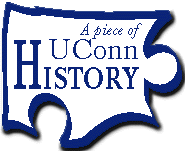Building names revisited, or how "the Jungle" got its name
March 9, 1998The eleven dormitories of North Campus were built in 1950 to
accommodate the surge of students that came in the post-World
War II years. The nickname "The Jungle" came about "because they
were over-crowded and noisy, originally housing male veterans
going to school on the G.I. Bill," wrote Evan Hill in his unpublished
history of the University.
Eight of the dorms in North Campus
are named for the counties of Connecticut: Fairfield, New Haven,
Litchfield, Middlesex, New London, Hartford, Tolland, and Windham.
The other three are named for former Connecticut governors.
- Baldwin
Hall is named for Raymond E. Baldwin, a Republican governor from
1939 to 1941 and 1943 to 1946. He was a U.S. senator from 1946
to 1949 and chief justice of the state Supreme Court from 1959
to 1963. It was Baldwin who, as governor, signed legislation
in 1939 changing the name of Connecticut State College to the
University of Connecticut.
- McConaughy Hall is named for James
L. McConaughy, a Republican governor from 1947 until his death
in 1948. He was president of Wesleyan University from 1925 to
1943 and lieutenant governor under Raymond Baldwin in 1939-1940.
- Hurley
Hall is named for Robert A. Hurley, a Democratic governor from
1941 to 1943. As commissioner of the state Department of Public
Works from 1937 to 1940, Hurley oversaw $5 million worth of construction
on the Storrs campus, including the Wilbur Cross Building, the
Design and Resource Management Building, and Manchester, Whitney,
Sprague and Wood Halls.
The Northwest Quadrangle, known as The
Frats, also was built in 1950. These units, which at one time
housed 23 fraternities, are named for 19th-century Connecticut
businessmen.
- Batterson Hall is named for James G. Batterson
(1823-1901), founder of The Travelers Insurance Company and a
leading contractor in granite and stone works. One of his projects
was the State Capitol in Hartford.
- Goodyear Hall is named for
Charles Goodyear (1800-1860) of New Haven, inventor of a system
of vulcanizing rubber.
- Hanks Hall is named for Benjamin and
Rodney Hanks, inventors who lived on Hanks Hill in Mansfield.
Benjamin (1755-1824) cast cannon for the Revolutionary war and
patented a tower clock powered by wind. Rodney (1782-1846) invented
machines for spinning silk with water power. He built the nation's
first silk mill in Mansfield, a structure now in the Ford Museum
in Dearborn, Mich.
- Rogers Hall is named for three brothers who
were pioneers in the silver industry. Simeon, Asa, and William
Rogers were the first to use electroplating in the commercial
production of silver-plated flatware.
- Russell Hall is named
for Samuel Russell (1789-1862), a Middletown businessman who was
involved in early trade with China.
- Terry Hall is named for
Eli Terry (1772-1852), operator of a clock factory in Terryville,
Connecticut. Terry, who started in business with Seth Thomas and
Silas Hoadley beginning in 1807, soon established his own company
and patented about 10 improvements on clocks.
- Wright Hall is
named for Benjamin Wright (1770-1842), a Wethersfield native
who was designated the "father of American civil engineering"
by the Society of American Civil Engineering. He was chief engineer
in the construction of the Erie Canal, St. Lawrence Ship Canal,
and the New York and Erie Railroads.
Over at Hilltop are the
last new dormitories to be built before construction began last
year on the new South Campus. Opened in 1971, the two dormitories
and dining facility are named for three Connecticut men from
the Revolutionary and Federal period.
- Ellsworth Hall is named
after Oliver Ellsworth of Windsor, a delegate to the Constitutional
Convention of 1787. He played a major
role in bringing about
the Connecticut Compromise, which provided for a bicameral Congress.
He was a U.S. senator from 1789-96 and chief justice of the U.S.
Supreme Court from 1796-1800.
- Hale Hall is named for Nathan
Hale (1755-76), an American patriot caught by the British and
hanged as a spy. Born in Coventry, he graduated from Yale in
1773.
- Putnam Refectory is named for Israel Putnam (1717-1790),
a captain in the French and Indian War and major general under
George Washington during the Revolution. It is Putnam who is
supposed to have said at Bunker Hill "Don't fire until you see
the whites of their eyes."
Mark J. R.
Source: unpublished manuscript,
Evan Hill, 1981. Additional information about the history of
the University can be found in the University Archives of the
Thomas J. Dodd Research Center.
|


